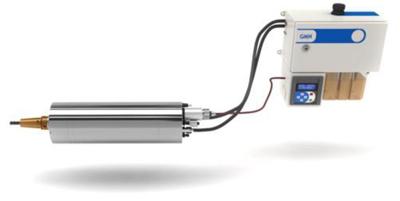
GMN says its new range of high-speed spindles with highly efficient hydroviscous damping reduces natural vibrations by up to 65 percent in comparison with standard spindles. This makes for more cost-effective workpiece machining, since components can be worked consistently with greater cutting depths and therefore higher material-removal rates. Improved surface quality is obtained at all speeds, not only for rough-machining, but also during the finishing process and grinding.
The new high-speed spindles are characterised by a vastly improved dynamic stiffness, according to Dr.-Ing. Bernd Möller, Head of Development & Construction at GMN: "Thanks to the hydroviscous system, damping of natural vibrations is enhanced considerably. In the axial direction, it was possible to achieve an improvement in dynamic stiffness, for example, of up to 135 percent. This results in significantly reduced natural vibrations in the machining process, enabling the production of components of very high quality."
When using standard spindles, on the other hand, high machining forces often lead to "rattling" caused by insufficient damping of natural vibrations. Such loud noises are symptomatic of the strong impulses generated by natural vibration. Potential serious consequences include rough, partly scratched surfaces, uneven cutting edges, widened grooves through to fractured workpieces, and even spindle failure.
An investigation by the Laboratory of Machine Tools and Production Engineering (WZL) at the Rhine-Westphalia Institute of Technology Aachen concluded that it was possible to double the minimum stable cutting depth at speeds between of 10,000 and 18,000 rpm with the high-speed spindle HCS 280 – 18000/60 with HSK-100. When using spindles with hydroviscous damping, consistently good surface results were obtained up to a plunge depth of 6mm, even at unfavourable speeds. Conversely, a depth of only 3mm was achieved using a standard spindle under the same conditions.
Surface quality was also noticeably improved for internal cylindrical grinding and surface grinding. Under production conditions at GMN's own manufacturing facility, for example, a hydroviscously damped spindle produced a roughness of only 0.89 µm compared with 2.36 µm using standard models.
The new high-speed spindles are independently driven by their own small, energy-saving hydraulic power unit. In addition, the bearing preload of the spindle can be controlled via the oil pressure. In this way, the rigidity of the spindle can be modified and therefore its behaviour optimised depending on machining task, speed, and tool. Increased preload can, for example, be used to significantly improve spindle performance at lower speeds.
The new spindle models with hydroviscous damping are available for machining centres for use in milling and drilling operations as well as for grinding machines. Because they are structurally identical to the standard models, they can also be easily retrofitted to existing machines.
GMN has carried out exhaustive field tests on hydroviscously damped spindles at the machining centres of an Italian manufacturer. Their customers have used the new spindles to produce components for the aviation industry, for example, and are completely satisfied. Development and Construction head Bernd Möller has also received positive feedback from GMN's in-house production: "Personnel operating the grinding machines were reluctant to hand back the new spindles following the trial runs."
Contact Details
Related Glossary Terms
- cylindrical grinding
cylindrical grinding
Grinding operation in which the workpiece is rotated around a fixed axis while the grinding wheel is fed into the outside surface in controlled relation to the axis of rotation. The workpiece is usually cylindrical, but it may be tapered or curvilinear in profile. See centerless grinding; grinding.
- dynamic stiffness
dynamic stiffness
Measure of a machining system’s ability to dampen vibration from a forced input. If the dynamic stiffness of a system is not sufficient to dampen vibration, chatter occurs. See static stiffness; stiffness.
- gang cutting ( milling)
gang cutting ( milling)
Machining with several cutters mounted on a single arbor, generally for simultaneous cutting.
- grinding
grinding
Machining operation in which material is removed from the workpiece by a powered abrasive wheel, stone, belt, paste, sheet, compound, slurry, etc. Takes various forms: surface grinding (creates flat and/or squared surfaces); cylindrical grinding (for external cylindrical and tapered shapes, fillets, undercuts, etc.); centerless grinding; chamfering; thread and form grinding; tool and cutter grinding; offhand grinding; lapping and polishing (grinding with extremely fine grits to create ultrasmooth surfaces); honing; and disc grinding.
- milling
milling
Machining operation in which metal or other material is removed by applying power to a rotating cutter. In vertical milling, the cutting tool is mounted vertically on the spindle. In horizontal milling, the cutting tool is mounted horizontally, either directly on the spindle or on an arbor. Horizontal milling is further broken down into conventional milling, where the cutter rotates opposite the direction of feed, or “up” into the workpiece; and climb milling, where the cutter rotates in the direction of feed, or “down” into the workpiece. Milling operations include plane or surface milling, endmilling, facemilling, angle milling, form milling and profiling.
- stiffness
stiffness
1. Ability of a material or part to resist elastic deflection. 2. The rate of stress with respect to strain; the greater the stress required to produce a given strain, the stiffer the material is said to be. See dynamic stiffness; static stiffness.
- surface grinding
surface grinding
Machining of a flat, angled or contoured surface by passing a workpiece beneath a grinding wheel in a plane parallel to the grinding wheel spindle. See grinding.
